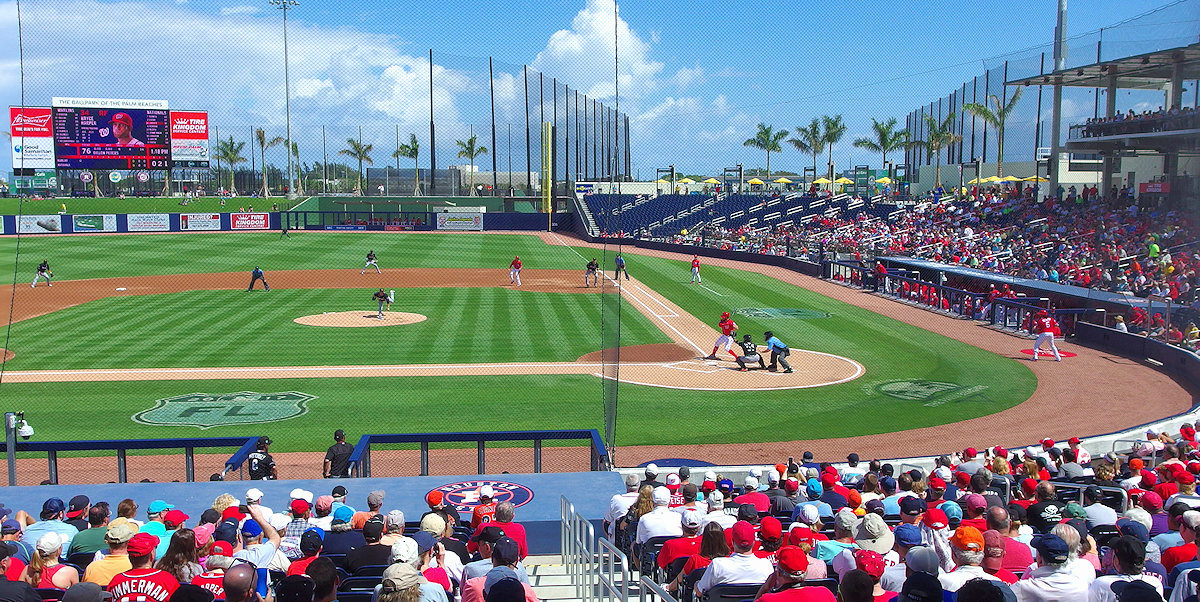Article by Joe Mock, BaseballParks.com
All photos by Joe Mock, except as indicated
All rights reserved
When pro-sports franchises move to another city, it’s usually because they want a new facility or a bigger fan base.
But that’s not always the case.
| Ballpark Stats |
 |
| Teams: spring training for Astros and Nationals |
| First game: February 28, 2017, a 4-3 win by the Nationals over the Astros |
| Capacity: 7,800 (6,400 fixed seats plus room for 1,400 on the berm and patios) |
| Dimensions: LF – 335; LCF – 377; CF – 406; RCF – 386; RF – 335 |
| Architect: HKS |
| Construction: Hunt |
| Price: $148 million |
| Home dugout: the Astros use 3B dugout, Nationals use 1B dugout |
| Field points: North by northeast |
| Playing surface: Platinum TE Paspalum |
| Betcha didn’t know: Even if a corporate-sponsorship name is attached to the stadium one day, it must still end with the phrase “the Palm Beaches” |
The Houston Astros moved their spring training operations from Cocoa Beach, FL to the central-Florida city of Kissimmee in 1984. “The move was really done to be in the Orlando area, because there were plans to bring several Major League teams to that area,” Astros President Reid Ryan told me. He mentioned the Royals, Twins, Reds, Red Sox, Tigers and eventually the Braves as being teams the Astros could play with relatively short bus rides. “For a while, there were a cluster of teams to play.”
When their complex received upgrades in 2003, the Astros agreed to extend their lease through 2016. As team executives began to discuss what should happen at the end of that extension, they noticed something. “We looked up and saw that it was only us and the Braves left in central Florida. Those (other) teams moved out, so we’d lost all of our neighbors.
“It put us in a spot where every year, our guys were coming out of spring training worn out from all of the travel.”
Ryan explained that they began to explore all of their options. They looked at moving out of Florida (“In the past, Arizona was very aggressive in trying to get teams to move there from Florida,” he pointed out) and they investigated building a new complex in Kissimmee with another team or two. That’s because the cost of new spring complexes had risen so much that it was no longer feasible to open a new one for only one team.
Rumors flew that the Astros approached a number of other teams that trained in Florida. For a while, it appeared the Blue Jays were receptive, as their facility in Dunedin had fallen behind the times. In the end, they decided to stay put, which is when the Nationals entered the picture. They trained in Viera, about 50 miles from Orlando. They, too, had noticed the lack of teams in Central Florida, and if the Astros were leaving, things were going to be even more challenging.
Palm Beach County, which already had the Cardinals and Marlins training in a complex in Jupiter, entered the picture. Not only could they offer other teams for the Astros and Nationals to play, the Astros’ principal owner Jim Crain owns the Floridian Golf Club which is in the vicinity.
| What was left behind |
 |
| In order to move to Palm Beach, the Nationals left behind Space Coast Stadium in Viera (above), which opened in 1994. The Astros moved out of Osceola County Stadium in Kissimmee (below), which was built in 1984. Interestingly, the Florida State League team that used to play in Viera will now play in Kissimmee. They’re now called the Florida Fire Frogs. |
 |
Late in 2013, representatives of the two teams began serious negotiations with the County. For it to work, it needed to make sense for both teams as well as the County. “We worked out numerous analyses and financial sheets,” said Art Fuccillo, Executive Vice President of Lerner Enterprises (the Lerner family are the principal owners of the Nationals). “We brought in financial people and looked at all of the tourist-tax projections, and we were able to craft a smart package so that the County would know that they’d have the money to support the bonds” to pay for the complex.
Verdenia Baker is the Palm Beach County Administrator. She explained that “my Board felt strongly about securing spring training well into the future. The community was behind it, so we moved forward.”
Financially, it made sense for the County to make the commitment, which amounts to about $100 million, with another $25 million coming from the State of Florida. She said that her office estimates that the economic impact over the two years of construction was $232 million, when you include money spent by private firms in preparation for the arrival of the two teams. Beyond that, the fans of the four teams training in the County will spend around $100 million every spring. The resulting increase in state and local taxes should be about $5.6 million annually.
Spring training is big business.
But Baker explained that there were other considerations. “The presence of another two-team stadium here speaks volumes about Palm Beach County being a mecca for sports tourism. We have a number of baseball, softball, soccer, lacrosse and equestrian events here. And as people come here to visit and get used to being in paradise, they also tend to buy property, so there is also an impact in real estate.”
| Not far away |
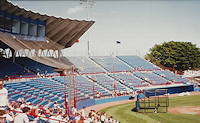 |
| Prior to the opening of the two-team complex in Jupiter in 1998, Palm Beach County was the spring home of the Braves and Expos. The complex was only one exit south on I-95 from the new Ballpark of the Palm Beaches. The photo below was taken in 2000 from the loading dock of a Home Depot as the old stadium was being demolished. Other than the name of the street (Hank Aaron Drive), today there’s no sign that spring training took place there from 1963 through 1997. |
 |
But there’s no doubt it’s good for the Astros and Nationals. In addition to the fantastic new facilities, their original goal of being closer to other teams has become a reality. “In relocating, we were looking for the synergy that could be created with other teams (nearby),” Fuccillo pointed out. “Our schedule is easier, as we take our bus trips down from 79 hours to 30 or 40 hours a spring.” That saves a lot of wear and tear on the players.
As an aside, the budget for the complex was $148 million — although the two teams made some late additions that they paid for directly, pushing the grand total higher. It’s interesting to compare that amount to the cost of building the complex in Jupiter — also in Palm Beach County, remember. It cost $28 million to build that project 20 years ago. In other words, a two-team complex now costs more than five times as much to build as it did two decades ago.
The name of the complex is also interesting, because The Ballpark of the Palm Beaches isn’t just for the stadium. “It was an idea that came to us through the Tourism Council,” Fuccillo recalled. “They said ‘We’re everything of the Palm Beaches. Do you think you could put that tag line in the name?’” So the teams considered names like “The Spring Training Complex of the Palm Beaches,” but that was too cumbersome. “Then we came up with Ballpark of the Palm Beaches, and it caught on.”
Adds Mo Stein, Principal at HKS, the architects for the complex, “It’s a very comfortable description, so it made a lot of sense.”
So the complex is now open and exhibition games are being played. Ryan calls it “the premier facility in all of Major League Baseball.” Is that accurate? How did it turn out, and what’s it like to attend a game there? Read on to find out.
The Setting
It would be nice if the new complex were next to restaurants and hotels, like in Peoria, AZ, or within walking distance of a robust shopping center and movies, like at Salt River Fields, or by an airport, like the Red Sox’ JetBlue Park in Fort Myers. But The Ballpark of the Palm Beaches isn’t in a bad spot at all. You just can’t walk to fancy restaurants or lodging.
The site is a large rectangle, bounded by Haverhill Road on the west, Military Trail on the east, near 45th Street on the north, and a canal on the south. While it’s basically in a suburban neighborhood, access to it is quite good. Exit 74 of I-95 is only a mile away, and for those coming from the Florida Turnpike, it’s about four miles from its exit 99. South Florida’s Tri-Rail commuter train’s Mangonia Park station is a short three-mile Uber ride away, and there’s municipal bus service that stops along the Military Trail side of the complex.
Verdenia Baker, Palm Beach County Administrator, adds that supporters of the Astros and Nationals will appreciate that “Palm Beach International Airport is just 15 minutes from the stadium, and it offers daily non-stop service from Washington and seasonal non-stop flights from Houston.”
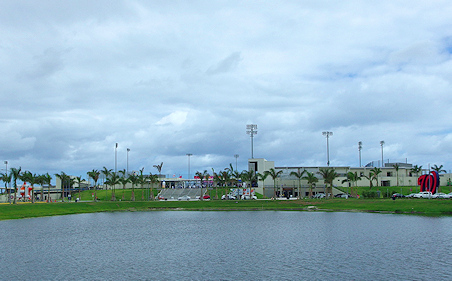 |
For many years, the spot was used as a dumping site – which sounds bad, if there was anything toxic being dumped there. But it wasn’t. It was largely debris from storms – trees, siding, chunks of concrete, etc. “I think we found one car, some tires, and an old refrigerator,” recalled Stein. “We also found some people camping out there, so they had to be moved. And we enticed an alligator to go someplace else!”
While it wasn’t easy to clean it all up (some debris remained until the summer of 2016), it wasn’t the remediation nightmare that some other ballparks have been built on. Stein added that many of the dead trees were ground up for mulch and pieces of concrete were crushed and used as a foundation on which to build. “And it was worth it to get to use this site. One with 160 acres in a major city that is well connected is hard to come by.”
And while it was the County that was negotiating with the two teams about moving there, they didn’t own this attractive piece of land. The City of West Palm Beach did. This prompted an interesting land swap, where a desirable parcel near downtown West Palm Beach that was owned by the County was traded to the City for the property that became the complex.
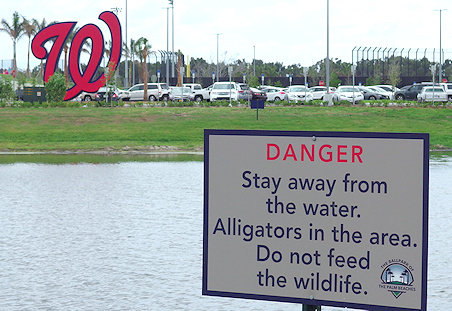 |
Stein added that “Anytime you have 160 acres, you should be able to do just about anything with it. The reality, though, is that there was a 13-acre lake on it, plus 27 acres had to act as a buffer zone along the canal. The teams are also giving the City a municipal park that is almost ten acres. So while the site is large, the space for building on it is much less than you’d think.”
We’ll look at the way that 110 acres is arranged in our next section.
The Exterior
As part of our discussion of the ballpark’s exterior, let’s look at the sprawling complex that surrounds it.
 |
| This tree-lined lane connects Haverhill Road with the the clubhouses and stadium, on the western part of the complex. |
The Astros side is to the north of ballpark, meaning the Nationals occupy the southern half of the complex. Each team has two full-size practice fields for their Major Leaguers to use, four fields for the Minor Leaguers (placed back-to-back in what is sometimes called a “quad” or “cloverleaf”), an infield-only space, covered batting cages and an agility field with an artificial surface. Both teams cleverly painted the outline of an infield on their agility field so it can serve a dual purpose.
Each team has a clubhouse that encompasses approximately 51,000 square feet. Here’s where the similarities between the two teams end. The Nats wanted their clubhouses to be connected to the ballpark in a way where players can walk through a tunnel under the park’s stands.
The Astros wanted none of that. “I’ve been in this game a long time,” said Ryan. “One thing I’ve learned is that you have to build that relationship with the fans. People who come down to spring training have an expectation that they’re going to get to know the Minor Leaguers, the coaches, get an autograph from a Major League player. We have to give them that opportunity.”
To accomplish this, Ryan explained that the Astros took a page from their former playbook. “Most people said that in Kissimmee, we had the best access in baseball.” That’s because the players had to walk out on the field from the clubhouse beyond left field to the third-base dugout, giving fans ample potential to talk to them and snare an autograph. That’s also the set-up in Palm Beach.
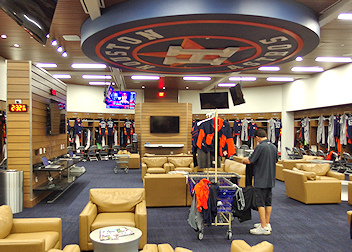  |
| Here’s your sneak peek at the Astros’ Major League lockerroom. As is the case with all recently built spring-training clubhouses, the room’s shape is an oval, so there are no corners. On the right is a look at the fields where the Astros’ Minor Leaguers practice. |
Another difference between the Nats and Astros comes in the way the young Minor Leaguers interact with the Big Leaguers – or don’t. While the Nationals want their young players to feel as though they need to earn the right to share space with the veterans, the Astros “wanted to create the concept of organizational unity, of being one team,” Ryan said. “We want our younger players seeing what it takes to be a Big Leaguer. We want there to be interaction. We think there’s some positive influence there.” Consequently, the Astros’ Minor Leaguers are practicing alongside the older players.
“On the Astros’ side, the weight room is in the middle and there’s centralized hydrotherapy rooms,” Stein explained. “The agility field is essentially in the middle, where everything is kind of surrounding it. It’s a very deliberate plan that’s very efficient. You can see their thinking.
“The Nats have a different philosophy,” he continued. “They’ve split their Minor Leaguers and Major Leaguers up, much the way the D-backs did (at Salt River Fields).”
These differences have more of an impact on the interior of each team’s clubhouse buildings than out on their practice fields, but it’s interesting the way each team’s philosophy was accommodated by the architects at HKS. “Each team was able to get what they wanted,” Stein summarized.
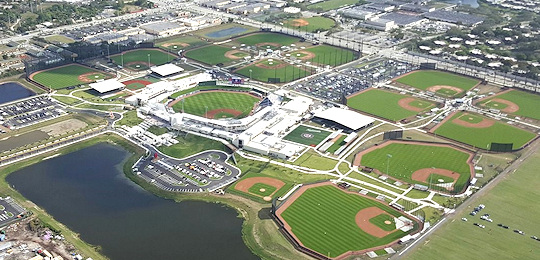 |
| This aerial shot was taken looking toward the northeast, from over Haverhill Road. The unfinished area in the lower left corner will be a city park one day. The Astros’ side of the complex is in the upper left, while the Nationals occupy the lower right. The empty space in the bottom righthand corner is used for parking during spring training, then it will be used for soccer and other sports. Aerial photo by Johann Hoffend from the Twitter account @Chopper5WPTV. Used by permission of WPTV. |
If you look at an aerial view of the complex (like above), you’ll more or less see the Astros’ fields and clubhouse on the northern half of the complex, while the Nationals occupy the southern portion. As mentioned above, the Astros’ players get to the dugout by walking out on the field down the third-base line, because the clubhouse is beyond left field. The Nats, though, walk through a tunnel under the stands to get to their dugout, which is on the first-base side. “This is more of a Major League connection,” said Stein. This makes perfect sense because their clubhouse is behind home plate and first base.
Because of the canal along the southern border of the site, there’s a buffer zone where no fields or buildings could be constructed. During exhibition games, this is used for parking for fans (below left). After spring training, the plan is to use this level ground for youth soccer fields.
 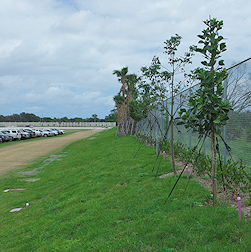 |
| On the left is the parking area on the southern edge of the complex, closest to the canal. On the right is the embankment and heavy fencing that keeps creatures like alligators out of the complex. |
And don’t worry about that pesky alligator invading a soccer match. There is now a sturdy fence on top of an embankment that separates the canal from this area (above right).
This is where most fans park for exhibitions, though, and it makes for a fairly long walk to the gates of the ballpark. It’s a pleasant walk, though, through the Nationals’ practice fields (below left).
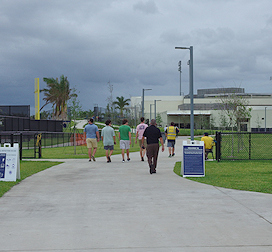  |
| It’s a long — but pleasant — walk from the parking area to the stadium. And since we gave you a behind-the-scenes look at the Astros’ clubhouse, on the right is something most fans won’t get to see: the Nationals’ outdoor swimming pool. Just inside the building there are the hydrotherapy facilities. |
The ballpark itself is the key to the complex’s layout. “The stadium is centralized, but it’s not actually in the center,” Stein explained. When a two-team spring training stadium is in the middle of the complex, “you get convenience and patterns for the players that are unequalled. What you (also) get, though, is longer distances from parking. What you want to do is make short distances for the players without making the fans walk forever, although it is an opportunity for engagement (between fans and players).”
There is a smaller parking lot in the northwest corner of the site, as well as one for the players (and, one day, for folks attending baseball tournaments that will be held on the quads) east of the stadium. The majority of parking, though, is on the southern edge near the canal. All of the paths from these lots lead you to the western side of the ballpark.
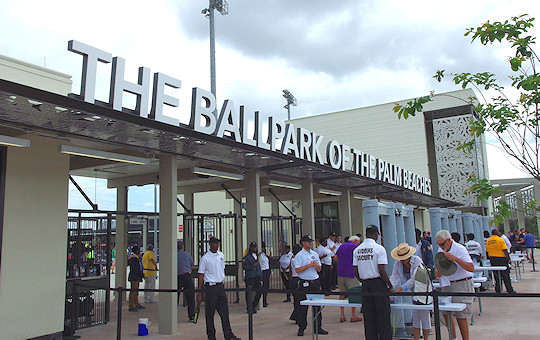 |
In other words, there is no entry gate on the east side – or for that matter, on the northern or southern sides. All ticket windows and gates are on the west side.
And on that west side is a feature (below) that makes the complex extremely useful for the County. “The entry plaza is 35,000 square feet and it’s designed so you could start a 10K or host a community arts fair or hold a festival,” Stein said. “When the stadium isn’t being used, it will be a great public amenity.” He added that it’s quite scenic because it is right beside a large, natural lake.
 |
Connecting that plaza to the ballpark is what Stein calls “the grand stairway.” It’s needed because the main concourse is about 14 feet above ground level.
Most fans will never see the other three sides of the stadium. Consequently, there’s not a lot of ornamentation to the exterior of those sides. “It’s odd. I’m not sure why they did that,” observed Graham Knight, author of the Florida Spring Training Ballpark Guide. “In that respect, it reminds me of the ballpark in Surprise, Arizona where the backside of the park’s main structure faces only toward the practice fields.”
 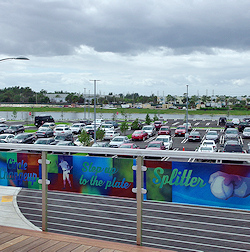 |
| On the left is the area in front of the lobby of the Nationals’ building. On the left portion of the shot you’ll notice a bridge that carries fans to the stadium’s main gates. The photo on the right was taken from that bridge. Note the signs with baseball terms and phrases, like “Splitter” and “Step up to the plate.” |
What fans are likely to see of the outside of Palm Beach’s stadium – its western exterior – is pleasant enough. There’s nice landscaping and lots of bright colors. There are two bridges that carry foot traffic toward the main ticket windows. Each has a series of cute signs that contain a colorful baseball cliché. The walkways beneath both bridges lead you to the main lobbies of the two teams’ offices and clubhouses.
Click below for a look at the inside of the stadium and what it’s like to attend a game here.
